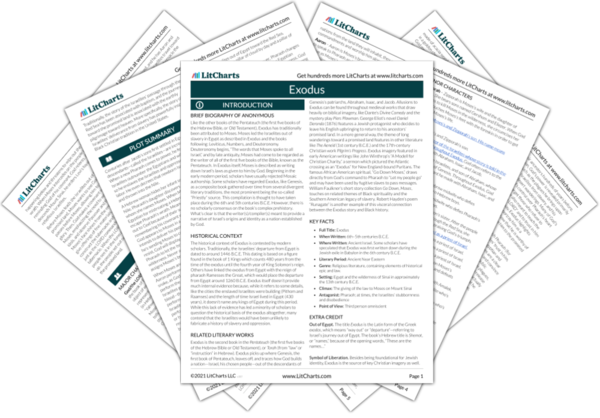Welcome to the LitCharts study guide on Anonymous's Exodus. Created by the original team behind SparkNotes, LitCharts are the world's best literature guides.
Exodus: Introduction
Exodus: Plot Summary
Exodus: Detailed Summary & Analysis
Exodus: Themes
Exodus: Quotes
Exodus: Characters
Exodus: Terms
Exodus: Symbols
Exodus: Theme Wheel
Brief Biography of Anonymous

Historical Context of Exodus
Other Books Related to Exodus
- Full Title: Exodus
- When Written: 6th–5th centuries B.C.E.
- Where Written: Ancient Israel. Some scholars have speculated that Exodus was first written down during the Jewish exile in Babylon in the 6th century B.C.E.
- Literary Period: Ancient Near Eastern
- Genre: Religious literature, containing elements of historical epic and law.
- Setting: Egypt and the wilderness of Sinai in approximately the 13th century B.C.E.
- Climax: The giving of the law to Moses on Mount Sinai
- Antagonist: Pharaoh; at times, the Israelites’ stubbornness and disobedience
- Point of View: Third person omniscient
Extra Credit for Exodus
Out of Egypt. The title Exodus is the Latin form of the Greek exodos, which means “way out” or “departure”—referring to Israel’s journey out of Egypt. The book’s Hebrew title is Shemot, or “names,” because of the opening words, “These are the names…”
Symbol of Liberation. Besides being foundational for Jewish identity, Exodus is the source of key Christian imagery as well. Traditionally, the story of the Israelites’ passage through the Red Sea has been associated with baptism, and the journey toward the promised land is associated with the earthly pilgrimage toward heaven. More specifically, the story of the Israelites’ deliverance from slavery has powerfully inspired the Black Christian tradition in the United States.







